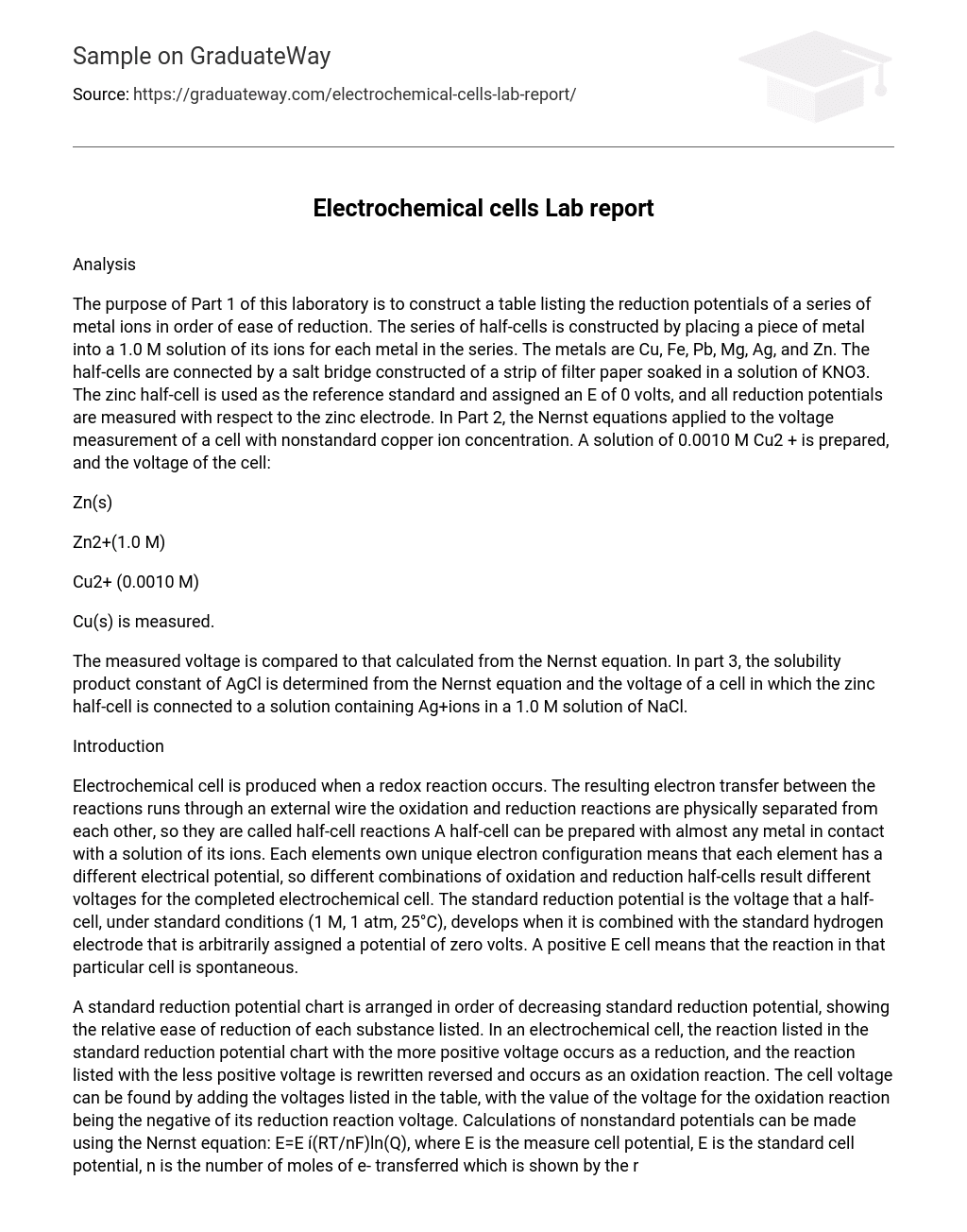Analysis
The purpose of Part 1 of this laboratory is to construct a table listing the reduction potentials of a series of metal ions in order of ease of reduction. The series of half-cells is constructed by placing a piece of metal into a 1.0 M solution of its ions for each metal in the series. The metals are Cu, Fe, Pb, Mg, Ag, and Zn. The half-cells are connected by a salt bridge constructed of a strip of filter paper soaked in a solution of KNO3. The zinc half-cell is used as the reference standard and assigned an E of 0 volts, and all reduction potentials are measured with respect to the zinc electrode. In Part 2, the Nernst equations applied to the voltage measurement of a cell with nonstandard copper ion concentration. A solution of 0.0010 M Cu2 + is prepared, and the voltage of the cell:
Zn(s)
Zn2+(1.0 M)
Cu2+ (0.0010 M)
Cu(s) is measured.
The measured voltage is compared to that calculated from the Nernst equation. In part 3, the solubility product constant of AgCl is determined from the Nernst equation and the voltage of a cell in which the zinc half-cell is connected to a solution containing Ag+ions in a 1.0 M solution of NaCl.
Introduction
Electrochemical cell is produced when a redox reaction occurs. The resulting electron transfer between the reactions runs through an external wire the oxidation and reduction reactions are physically separated from each other, so they are called half-cell reactions A half-cell can be prepared with almost any metal in contact with a solution of its ions. Each elements own unique electron configuration means that each element has a different electrical potential, so different combinations of oxidation and reduction half-cells result different voltages for the completed electrochemical cell. The standard reduction potential is the voltage that a half-cell, under standard conditions (1 M, 1 atm, 25°C), develops when it is combined with the standard hydrogen electrode that is arbitrarily assigned a potential of zero volts. A positive E cell means that the reaction in that particular cell is spontaneous.
A standard reduction potential chart is arranged in order of decreasing standard reduction potential, showing the relative ease of reduction of each substance listed. In an electrochemical cell, the reaction listed in the standard reduction potential chart with the more positive voltage occurs as a reduction, and the reaction listed with the less positive voltage is rewritten reversed and occurs as an oxidation reaction. The cell voltage can be found by adding the voltages listed in the table, with the value of the voltage for the oxidation reaction being the negative of its reduction reaction voltage. Calculations of nonstandard potentials can be made using the Nernst equation: E=E í(RT/nF)ln(Q), where E is the measure cell potential, E is the standard cell potential, n is the number of moles of e- transferred which is shown by the redox reaction, R is the gas constant (8.314 J/mol ∙ K), T, is temperature in Kelvin, n is the number of moles of electrons transferred as shown by the redox reaction, finally, F is faradays constant, (9.64×104). At STP Nernst equation can be simplified down to E=E˚-(.0592/n)logQ.
The predicted potentials for this chart were derived from the voltages of the half cells. For example, when the redox reaction between Mg and Cu was balanced, the reduction potential and the oxidation potential of the ions were added.
Post-Lab Questions
- An electrode potential is created by comparing the potential of a metal, such as zinc in this lab, and potentials under standard conditions, as in published tables.
- Yes, the ranking was consistent between the reduction equations and the published chart of E values.
- The values found by using the zinc electrode should be higher than the values from the hydrogen electrode because the standard reduction potential of zinc is lower than that of hydrogen. Thus, when zinc becomes the standard, the voltages shift upward in response to the change.
- Answer
- A negative value for a standard potential indicates that oxidation occurs rather than reduction. For example, the electron potential using zinc as the standard of Mg was negative because when it reacted with Zn, Mg was the anode and Zn was the cathode.
- The change in concentration of the copper ions in part 2 affected the cell potential by making it lower. If the copper ions had not been diluted, the molarity would be 1.0. Log(1)=0, so the value of E would be .89V instead of .80V. Le Chatlier’s principle would predict that because the concentration of Cu2+ ions would be greater, the reaction would shift to the reactants side, yielding more zinc.
- The solubility product of AgCl was determined by the equation: There is no percent error in for the report. The Nernst equation was the most used equation in this experiment. In the experiment multiple cells were created, and hooked up to a volt meter to find the charge.





